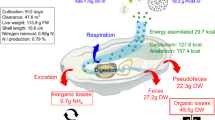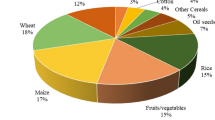Abstract
The characteristics of a river are shaped by the quality of the tributaries that flow into it and each of the tributaries in turn reflects the management practices that occur on the soils and landscapes in their drainage areas. In the Cottonwood River of Minnesota, USA and many of its tributaries, nutrient enrichment [primarily nitrogen (N) and phosphorus (P)] and suspended sediments contribute to nonpoint source pollution. Our objective was to assess farm characteristics and nutrient management practices among producer/operators in two southwestern Minnesota watersheds, and relate these characteristics to soil and landscape differences as reflected by agroecoregions. Producer/operators were interviewed in a face-to-face interview during summer 2002 about agricultural production management practices in two tributaries of the Cottonwood River. The Sleepy Eye Creek watershed (SECW) is located in gently rolling to flat soils formed in glacial till. The Highwater-Dutch Charley Creek watershed (HDCCW) is located in moderately steep, 2–6% slope, soils formed in glacial moraine. Nitrogen and P rates applied to corn were significantly greater in the SECW than the HDCCW, and more of the N was applied in the fall in the SECW than in the HDCCW, where more was applied in spring. More farmers tested soil for plant available P in the SECW than in the HDCCW. Results from both watershed indicated that forty-seven (29%) fields with soil test phosphorus records exceeded 25 ppm (Bray 1) or 20 ppm (Olsen). Nineteen (7.4%) fields received applications of both manure and N fertilizer, and 13 (5.1%) fields received applications of both manure and phosphate (P) fertilizer. Nitrogen and P application rates ranged from 234 to 315 kg N ha−1 and 134 to 168 kg P2O5 ha−1 for fields receiving both manure and fertilizer. Strategies for improving nutrient management practices in these two watershed areas should take into consideration soil and landscape differences that influence which nutrient management practices are most risky and which are most likely to improve water quality.
Similar content being viewed by others
References
Antweiler, R. C., Goolsby, D. A. and Taylor, H. E.: 1995, ‘Nutrients in the Mississippi River’, in: R.H. Meade (ed.), Contaminants in the Mississippi River, 1987–1992. U.S. Geological Survey Circ. 1133.
Birr, A. S. and Mulla, D. J.: 2002, ‘Relationship between lake and ground water quality patterns and Minnesota agroecoregions’, Hydrological Sci. Tech. 18, 31–41.
Bock, B. R. and Hergert, G. W.: 1991, ‘Fertilizer nitrogen management’, in R. F. Follett, D. R. Keeney, and R. M. Cruse (eds.), Managing nitrogen for groundwater quality and farm profitability. Soil Sci. Soc. Am. Madison, WI.
Carpenter, S. R., Caraco, N. F., Correll, D. L., Howarth, R. W., Sharpley, A. N. and Smith, V. H.: 1998, ‘Nonpoint pollution of surface waters with phosphorus and nitrogen’, Ecol. Appl. 8, 559–568.
Caraco, N. F. and Cole, J. J.: 1994, ‘Human impact on nitrate export: An analysis using major world rivers’, Ambio 28, 167–170.
Castillo, M. M., Allan, J. D. and Brunzell, S.: 2000, ‘Nutrient concentrations and discharges in a midwestern agriculutral catchment’, J. Environ. Qual. 29, 1142–1151.
Cohen, P., Andriamaahefa, H. and Wasson, J. G.: 1998, ‘Toward a regionalization of aquatic habitat: Distribution of meso-habitats at the scale of a large basin,’ Reg. River Reser. Manag. 14, 391–404.
Dinnes, D. L., Karlen, D. L., Jaynes, D. B., Kaspar, T. C., Hatfield, J. L., Colvin, T. S. and Cambardella, C. A.: 2002. ‘Nitrogen management strategies to reduce nitrate leaching in tile drained Midwestern soils’, Agron. J. 94, 153–171.3
Dovciak, A. L. and Perry, J. A.: 2002, ‘In search of effective scales for stream management: Does agroecoregion, watershed, or their intersection best explain the variance in stream macroinvertebrate communities?’
Edwards, A. C., Twist, H. and Codd, G. A.: 2000, ‘Assessing the impact of terrestrially derived phosphorus on flowing water systems’, J. Environ. Qual. 29, 117–124.
European Commission.: 2000, ‘Council Directive Concerning the Water Framework Directive (2000/60/EC)’, http://europa.eu.int/comm/environment/water/water-framework/index_en.html.
Feinerman, E., Choi, E. K. and Johnson, S. R.: 1990, ‘Uncertainty and split nitrogen applications in corn production’, Am. J. Agric. Econ. 72, 975–984.
Gast, R. G., Nelson, W. W. and Randall, G. W.: 1978, ‘Nitrate accumulation in soils and loss in tile drainage following nitrogen applications to continuous corn’, J. Environ. Qual. 7, 258–261.
Gilliam, J. W., Baker, J. L. and Reddy, K. R.: 1999, ‘Water quality effects of drainage in humid regions’, in R. W. Skaggs and J. van Schilfgaarde (eds.), Agricultural drainage, Agron. Monogr. 38. ASA, CSSA, and SSSA, Madison, WI, pp. 801–830.
Hatch, L. K., Mallawatantri, A., Wheeler, D., Gleason, A., Mulla, D., Perry, J., Easter, K. W., Smith, R., Gerlach, L. and Brezonik, P.: 2001, ‘Land management at the major watershed — agroecoregion intersection’, J. Soil Water Conserv. 56, 44–51.
Haycock, N. E., Pinay, G. and Walker, C.: 1993, ‘Nitrogen retention in river corridors: European perspectives’, Ambio 22, 340–346.
Howarth, R. W., Billen, G., Swaney, D., Townsend, A., Jaworski, N., Lajtha, K., Downing, J. A., Elmgren, R., Caraco, N., Jordan, T., Berendse, F., Freney, J., Kudeyarov, V., Murdoch, P. and Zhao-Liang, Z.: 1996, ‘Regional ntrigoen budgets and riverine N& P fluxes for the drainages to the North Atlantic Ocean: Natural and human influences’, Biogeochemistry 35, 75–139.
Jaynes, D. B., Kaspar, T. C., Moorman, T. B. and Parkin, T. B.: 2004, ‘Potential methods for reducing nitrate losses in artificially drained fields’, 8th International Drainage Symposium, pp. 59–69. Sacramento, CA.
Magdoff, F. R., Ross, D. and Amadon, J.: 1984, ‘A soil test for nitrogen availability to corn’, Soil Sci. Soc. Am. J. 48, 1301–1304.
Midwest Plan Service.: 1993, ‘Manure Characteristics’, Midwest Plan Service, Ames, IA.
Montgomery, B. R. and Bruening, D.: 1997, ‘Current nutrient management strategies on Minnesota’s outwash sands’, in Proc. U. S. Committee on Irrigation and Drainage Conf. on Best Management Practices for Irrigated Agriculture and the Environment. Jul. 16–19, 1997, Fargo, ND.
Mueller, D. H., Wendt, R. C. and Daniel, T. C.: 1984, ‘Phosphorus loss as affected by tillage and manure application’, Soil Sci. Soc. Am. J. 48, 901–905.
Omernik, J. M.: 1987, ‘Ecoregions of the conterminous United States’, Ann. Assoc. AM. Geogr. 77, 118–125.
Omernik, J. M. and Bailey, R. G.: 1997, ‘Distinguishing between watersheds and ecoregions’, J. Am. Water Resour. Assoc. 33, 935–949.
Rabalais, N. N., Turner, R. E., Justic, D., Dortch, Q., Wiseman, J. W., Jr. and Sen Gupta, B. K.: 1996, ‘Nutrient changes in the Mississippi River and System Response on the Adjacent Continental Shelf’, Estuaries 19(2B), 385–407.
Rabalais, N. N., Turner, R. E. and Wiseman, W. J., Jr.: 2001, ‘Hypoxia in the Gulf of Mexico’, J. Environ. Qual. 30, 320–329.
Randall, G. W., Huggins, D. R., Russelle, M. P., Fuchs, D. J., Nelson, W. W. and Anderson, J. L.: 1997, ‘Nitrate losses through subsurface tile drainage in CRP, alfalfa, and row crop systems’, J. Environ. Qual. 26, 1240–1247.
Randall, G. W., Vetsch, J. A. and Huffman, J. R.: 2003, ‘Corn production on a subsurface-drained mollisol as affected by time of nitrogen application and nitrapyrin’, Agron. J. 95, 1213–1219.
RCRCA.: 1999, ‘Cottonwood River Restoration Project: Final Report’, Redwood-Cottonwood Rivers Control Project, Redwood Falls, MN.
Rehm, G., Schmitt, M., Randall, G., Lamb, J. and Eliason, R.: 2000, ‘Fertilizing corn in Minnesota’, Univ. Minnesota Ext. Bull. FO-3790-C.
Rehm, G., Schmitt, M., Lamb, J. and Eliason, R.: 2001, ‘Fertilizing soybeans in Minnesota’, Univ. Minnesota Ext. Bull. FS-3813-A.
SAS.: 2002, SAS Version 8. 2. SAS, Cary, NC.
Schmitt, M. A.: 1999, ‘Manure management in Minnesota’, University of Minnesota Extension, St. Paul, MN. FO-3553-C.
USDA-SCS.: 1979, ‘Getting the most out of your raindrop: Hydrology guide for Minnesota’, U.S.D.A — Soil Conservation Service, St. Paul, MN.
Author information
Authors and Affiliations
Corresponding author
Rights and permissions
About this article
Cite this article
Strock, J.S., Bruening, D., Apland, J.D. et al. Farm Nutrient Management Practices in Two Geographically Diverse Watersheds in the Cottonwood River Watershed of Minnesota, USA. Water Air Soil Pollut 165, 211–231 (2005). https://doi.org/10.1007/s11270-005-5417-x
Received:
Accepted:
Issue Date:
DOI: https://doi.org/10.1007/s11270-005-5417-x




